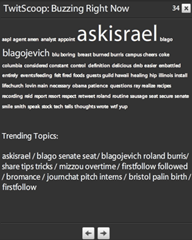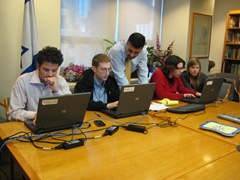Yesterday, Tuesday, December 30, 2008, was a landmark for Twitter as a service and for the world of digital public policy. The Israeli Consulate in New York held a citizens press conference on Twitter. Lasting two hours, it engaged everyone on Twitter, led trending topics, and allowed Israel to directly answer questions from one of the web’s biggest communities.
David Saranga, consul of media and public affairs in New York, is the primary force behind the Twitter conference. Consul Saranga is no stranger to the world of new media; he began the consulate’s social networking initiative in 2006. He also was the mind behind the ‘beer ‘n’ babes’ Maxim in Israel campaign.
“There is a lot of public interest regarding the operations in Israel,” Saranga said. “So we decided that if these people want to know about the events in Israel, the best way to do it is to ask us directly.”
Brave words, considering that some of the people he was seeking to engage in conversation had been standing outside his office the day before the conference with signs saying “Allah (SWT) will destroy the terrorist state of Israel.” Consul Saranga wasn’t worried.
“I don’t have a problem with any question,” he said.
“It’s the right of everyone to be informed and to hear what the people on the Israeli side will have to say,” Saranga emphasized.
With its 140 character limit, at first glance Twitter seems an odd choice for a Q&A, but there were good reasons for the choice.
“I definitely think that Twitter is on the ascent,” said Joshua S. Fouts the chief global strategist for Dancing Ink Productions and a senior fellow at the Carnegie Council for Ethics in International Affairs. Fouts is is currently working on a report for the Obama administration on Understanding Islam in Virtual Worlds. “It allows busy people to check in and see their questions in a time space that is more in-keeping with their flexibility or availability.”
“I think this [Twitter] is just another great avenue for communication,” said Tamar Weinberg, a blogger and social media consultant, who does some pro-bono consulting for the New York-based Israeli Consulate. “If there is one broadcast tool that everyone in the world should be using, maybe it should be Twitter.”
There were good PR reasons for using Twitter as well.
“Exposure for Twitter is heightened, especially among those who are less likely to use traditional media to get this kind of news,” Weinberg said.
Fouts has worked on communicating public policy through new media for the US State department in the 1990s.
“The more that governments steps outside of their comfort zones and experiments with the rapidly evolving technology, the better,” he said. “It behooves governments to use taxpayer dollars in a way that is current with the way the rest of the world is communicating.”
News of the event worked well for the Consulate–increasing its Twitter followers, hits on their websites, and visitors to their other web properties. Not only that, but people began to ask if this was the event that would make Twitter mainstream, resulting in coverage from a number of popular sources including Boing Boing, Wired and ArsTechnica.
Weinberg pointed out one of the best indications that the Consulate’s event was really bringing Twitter to the common man, or in this case, mom.
The Twitter conference began promptly at 1 p.m., but it was rough going at first. Shel Israel, a social media and Twitter expert who had intended to retweet the entire conference, publicly left 30 minutes into the event, tweeting “No real chance for interchange of ideas or to gain new insights. I’m checking out.”
At that point the Consulate’s twitter account was typing out answers about every five minutes, in comparison to the dozens of questions coming in every single minute. In addition to that, the first answers lacked the hash-tag marking them as part of the #askisrael topic, forcing many to turn to Tweet Grid, TweetDeck, FriendFeed or Tweettree to track the whole conversation.
Even with a program like Tweet Grid, some of the answers were phrased confusingly, as the Consulate attempted to compress highly complex discussions into 140 characters, including this early example: “MV DIg dnt respond 2 Calls 2 hult & rammed an IDF ship. it was escorted out 2 intl waters. till this opt. ships were let.” Which, with some work, might translate to “Medical Vessel Dignity didn’t respond to calls to halt and rammed an IDF ship. It was escorted out into international water. Until this operation, ships were let in.”

However, by 2:08 p.m., ‘askisrael’ was the top trending topic on TwitScoop, as ever increasing numbers of Twitter members joined the discussion and the Consulate’s replies increased in frequency and coherency.
“We really try to get as many questions as we can. We had so many of them and we tried to separate between the repeated questions and the original ones.” said Moriel Schottlender, the internet applications development manager for the consulate general of Israel in New York, one of the primary organizers for the event. “This was a little bigger than what we thought in terms of the amount of people that asked questions.”
With so many questions, even with a team behind the account the Consulate couldn’t keep up and had to ask for patience.
 Trying to keep up with all the questions, the single twitter account had around five people running the show. Schottlender used TweetDeck to track and organize the questions. Then the other team members wrote down and compressed Consul Saranga’s answers and sent them back for Schottlender to post online. When the group realized just how large the pool of questions they had to deal with was, they sent another member to Twitter’s web interface to help track questions and send tweets.
Trying to keep up with all the questions, the single twitter account had around five people running the show. Schottlender used TweetDeck to track and organize the questions. Then the other team members wrote down and compressed Consul Saranga’s answers and sent them back for Schottlender to post online. When the group realized just how large the pool of questions they had to deal with was, they sent another member to Twitter’s web interface to help track questions and send tweets.
“The capacity to manage the flow of questions going through is often times difficult.” Fouts said. “Twitter, in particular, allows the people who are hosting the questions to receive and organize them in a way that is more structured and it allows the participants to participate in a way that is more manageable for them, because its asynchronous.”
Schottlender was familiar with TweetDeck and found it the best tool for the job for a number of reasons.
Schottlender also noted the URL shortening tool and TweetShrink as useful features.
“The answers, a lot of times, are more complicated than 140 characters and it took some practice,” she said.
However, that difficulty also turned out to be an advantage.
“The fact that you have to limit yourself to 140 characters makes it necessary to answer in a precise way in a very clear way and to the point, when it comes to the message,” Saranga said. “The fact that we had to limit ourselves to 140 characters was a challenge that, at the end of the day, helped us to shape the message in a very clear an concrete way.”
“Twitter forces the writers, both the people asking and answering the questions, to be very precise about their questions,” Joshua Fouts explained. “From a journalistic standpoint, that’s always been what journalism is interested in, how do you get your lede down to the narrows amount of words possible.”
Between 1 and 3 p.m., the consulate had tweeted almost 70 times, answering around 60 questions. The conference left many community members satisfied.

“We were very happy to see that people were taking the time to ask serious questions,” Schottlender said. “We were hoping that people would communicate with us and join in on the discussion and in that aspect our hopes were met.”
The event generated a lot of interest in the Consulate and the sources it linked from its blog.
“The press conference on Twitter brought to us a lot of traffic in numbers we haven’t seen in the past,” Saranga confirmed. “People, at the end of the day, got what they wanted, more information from a reliable source about the events that are taking place in the Gaza Strip and from what I see, and the debate I see afterwards, I see that people are really satisfied.”
“Around 2000 followers in the less then 24 hours, since we just opened the account,” Saranga said. “I think it’s a good number.”
The conference tried something new on a technical level and succeeded.
“There was an overwhelming number of people that participated in it created an overload of questions which illustrated the interest in both the topic and the fact that presenting the topic in the Twitter venue was something that people thought was accessible enough, worldwide, for them to be a part of.” Fouts said. “It was also successful from a public diplomacy and public relations standpoint, it cast the Israeli consulate in a very technologically progressive light.”
What is in the future for the Israeli Consulate and for Twitter?
|
Hear more about Fouts’ project Understanding Islam in Virtual Worlds and what it means for the future.
|
Fouts foresees similar techniques being used in the future. He looks forward to seeing similar techniques in the Obama administration once he releases his report, which includes recommendations on how to use virtual worlds to better understand Islam.
“What social networking tools provide that traditional media doesn’t is it empowers citizens to be a part of the discourse,” Fouts said.
“Before the press conference was announced, no one really knew the existence of the blog, or the consulate’s presence on Twitter,” Weinberg said. “The number of followers completely blossomed.”
“I was very very happy to see the responses of the Twitter community,” said Schottlender. “We would want to use more then TweetDeck for the next time. We might want to use a shorter tag. These are technical things we learn as we go.”
Schottlender is considering a number of ways to improve the experience for all involved.
“We couldn’t really directly reply to a tweet, only to a user, because there was a delay,” she said. “We could use something that will help us stay on top of the multiple questions and answers while keeping the hierarchy.”
The functions Schottlender needs are in the Twitter API, but real-time access isn’t easy.
“I am considering building our own Twitter application. We need something that allows us to track questions online but allow for multiple users to type in final answers. Given the amount of questions we encountered—that might involve developing something of our own.”
On the topic of a second press conference, Saranga was positive that he would want a second one.
“Yes, absolutely yes.”
Saranga sees many future uses for the Twitter account.
“After the operation will end, we are going to go back and think and share our views about Israel, about different aspects of Israel,” he said. “Whether it’s about Israeli society, which is a multi-cultural society, whether it is about Tel Aviv, which is the capital of lifestyle today and the next hot spot when it comes to other aspects, I hope we can dialogue with people about the different ecological achievements of Israel and so on and so forth. I have no doubt that this platform will remain there for us to share Israel with the people out there in the world.”
Saranga proud to lead the way in governmental use of Twitter.
“We are pioneers in this experience.”
Hear More!
You can listen to further comments from the people in this article in the following podcast. This is the short version, so click the RSS link on the side and subscribe to the blog if you want to know when the longer version comes out.
(I apologize for any audio glitches, I’ve been having some bandwidth problems.)
Video and Photo by the Israeli Consulate































wrote my point of view of the current situation in Gaza:
Why children die in gaza
Thanks.